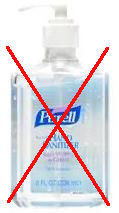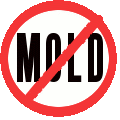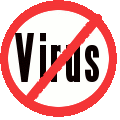Unlike other cleaners MonoClean is perfectly safe.
The primary component of MonoClean is monolaurin. There is no limit to the amount of monolaurin you can safely ingest. Even when you eat it there's no affect on the "good" bacteria in your digestive system. It's a natural compound that is fully biodegradable. It won't harm the environment.
Unlike other cleaners MonoClean leaves a film that protects for days or even months. If you clean the counter top with other cleaners a sneeze five minutes later will contaminate your clean surface. MonoClean keeps working.
Let's take a look at the safety of some other popular «anti-bacterial» product additives.
Triclosan
What we have here is a chlorinated phenol. Talk about hazardous!! This stuff can build up in your fat tissues. Triclosan plus chlorine plus uv light can equal dioxin- one of the most hazardous materials known to man. Trace amounts have been found in human breast milk. The EPA gives triclosan high scores both as a human health risk and as an environmental risk. Here's a few links from professionals on the subject:
|
Alcohol
 Hand sanitizers are all the rage. But really what are they? Most are over 60% ethyl alcohol. That's 120 proof! Thus they've been banned in several prisons. They need to be that high in alcohol because they cannot effectively kill germs at a lower percentage.
Hand sanitizers are all the rage. But really what are they? Most are over 60% ethyl alcohol. That's 120 proof! Thus they've been banned in several prisons. They need to be that high in alcohol because they cannot effectively kill germs at a lower percentage.
Since they are high in alcohol they ship as a hazardous product because of flammability. One of the purveyors of these products suggest that they should be placed in every classroom. Presuming you'd want to keep 32 oz. bottle in a class to service an average 25 students and your school has 36 classrooms that equals nine gallons of flammable material distributed throughout the building.
The health problem with alcohol sanitizers is that they dry your hands. In a study with nurses in the Philippines they found that after regular use for a month the nurses hands became red and irritated. When they used a monolaurin solution they found the reduction of pathogenic bacteria to be equal and hands didn't suffer the same uncomfortable results. Monolaurin is an emollient. It softens your hands.
MonoClean's Material Safety Data Sheet <<-- MSDS
What does this mean to you? It means you can buy a cleaner that is 100% safe around children, pets and chemically sensitized individuals. It means that any surface cleaned with MonoClean remains antimicrobial without using dangerous chemicals.


